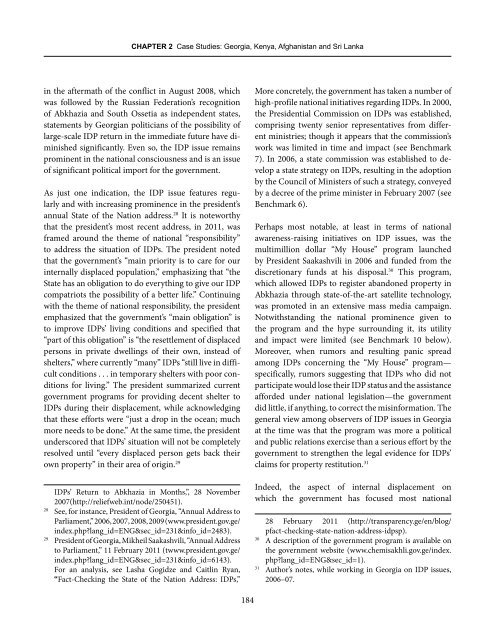From Responsibility to Response: Assessing National - Brookings
From Responsibility to Response: Assessing National - Brookings
From Responsibility to Response: Assessing National - Brookings
Create successful ePaper yourself
Turn your PDF publications into a flip-book with our unique Google optimized e-Paper software.
CHAPTER 2 Case Studies: Georgia, Kenya, Afghanistan and Sri Lanka<br />
in the aftermath of the conflict in August 2008, which<br />
was followed by the Russian Federation’s recognition<br />
of Abkhazia and South Ossetia as independent states,<br />
statements by Georgian politicians of the possibility of<br />
large-scale IDP return in the immediate future have diminished<br />
significantly. Even so, the IDP issue remains<br />
prominent in the national consciousness and is an issue<br />
of significant political import for the government.<br />
As just one indication, the IDP issue features regularly<br />
and with increasing prominence in the president’s<br />
annual State of the Nation address. 28 It is noteworthy<br />
that the president’s most recent address, in 2011, was<br />
framed around the theme of national “responsibility”<br />
<strong>to</strong> address the situation of IDPs. The president noted<br />
that the government’s “main priority is <strong>to</strong> care for our<br />
internally displaced population,” emphasizing that “the<br />
State has an obligation <strong>to</strong> do everything <strong>to</strong> give our IDP<br />
compatriots the possibility of a better life.” Continuing<br />
with the theme of national responsibility, the president<br />
emphasized that the government’s “main obligation” is<br />
<strong>to</strong> improve IDPs’ living conditions and specified that<br />
“part of this obligation” is “the resettlement of displaced<br />
persons in private dwellings of their own, instead of<br />
shelters,” where currently “many” IDPs “still live in difficult<br />
conditions . . . in temporary shelters with poor conditions<br />
for living.” The president summarized current<br />
government programs for providing decent shelter <strong>to</strong><br />
IDPs during their displacement, while acknowledging<br />
that these efforts were “just a drop in the ocean; much<br />
more needs <strong>to</strong> be done.” At the same time, the president<br />
underscored that IDPs’ situation will not be completely<br />
resolved until “every displaced person gets back their<br />
own property” in their area of origin. 29<br />
IDPs’ Return <strong>to</strong> Abkhazia in Months,”, 28 November<br />
2007(http://reliefweb.int/node/250451).<br />
28 See, for instance, President of Georgia, “Annual Address <strong>to</strong><br />
Parliament,” 2006, 2007, 2008, 2009 (www.president.gov.ge/<br />
index.php?lang_id=ENG&sec_id=231&info_id=2483).<br />
29 President of Georgia, Mikheil Saakashvili, “Annual Address<br />
<strong>to</strong> Parliament,” 11 February 2011 (twww.president.gov.ge/<br />
index.php?lang_id=ENG&sec_id=231&info_id=6143).<br />
For an analysis, see Lasha Gogidze and Caitlin Ryan,<br />
“Fact-Checking the State of the Nation Address: IDPs,”<br />
184<br />
More concretely, the government has taken a number of<br />
high-profile national initiatives regarding IDPs. In 2000,<br />
the Presidential Commission on IDPs was established,<br />
comprising twenty senior representatives from different<br />
ministries; though it appears that the commission’s<br />
work was limited in time and impact (see Benchmark<br />
7). In 2006, a state commission was established <strong>to</strong> develop<br />
a state strategy on IDPs, resulting in the adoption<br />
by the Council of Ministers of such a strategy, conveyed<br />
by a decree of the prime minister in February 2007 (see<br />
Benchmark 6).<br />
Perhaps most notable, at least in terms of national<br />
awareness-raising initiatives on IDP issues, was the<br />
multimillion dollar “My House” program launched<br />
by President Saakashvili in 2006 and funded from the<br />
discretionary funds at his disposal. 30 This program,<br />
which allowed IDPs <strong>to</strong> register abandoned property in<br />
Abkhazia through state-of-the-art satellite technology,<br />
was promoted in an extensive mass media campaign.<br />
Notwithstanding the national prominence given <strong>to</strong><br />
the program and the hype surrounding it, its utility<br />
and impact were limited (see Benchmark 10 below).<br />
Moreover, when rumors and resulting panic spread<br />
among IDPs concerning the “My House” program—<br />
specifically, rumors suggesting that IDPs who did not<br />
participate would lose their IDP status and the assistance<br />
afforded under national legislation—the government<br />
did little, if anything, <strong>to</strong> correct the misinformation. The<br />
general view among observers of IDP issues in Georgia<br />
at the time was that the program was more a political<br />
and public relations exercise than a serious effort by the<br />
government <strong>to</strong> strengthen the legal evidence for IDPs’<br />
claims for property restitution. 31<br />
Indeed, the aspect of internal displacement on<br />
which the government has focused most national<br />
28 February 2011 (http://transparency.ge/en/blog/<br />
pfact-checking-state-nation-address-idpsp).<br />
30 A description of the government program is available on<br />
the government website (www.chemisakhli.gov.ge/index.<br />
php?lang_id=ENG&sec_id=1).<br />
31 Author’s notes, while working in Georgia on IDP issues,<br />
2006–07.

















